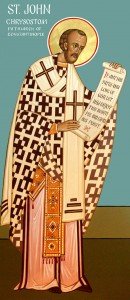 I have been attempting to share St. John Chrysostom’s thoughts about the Transfiguration. I would hasten to also point out that there are some scholars who believe that this event actually is actually a post-Resurrection event. It is an event that is plays an important role in the spirituality of our Eastern Church. This is one of the reasons why I have chosen to share the thoughts of our Fathers among the Saints about this topic. I realize that it can become rather pedantic, but I would encourage my readers to stick to reading about it.
I have been attempting to share St. John Chrysostom’s thoughts about the Transfiguration. I would hasten to also point out that there are some scholars who believe that this event actually is actually a post-Resurrection event. It is an event that is plays an important role in the spirituality of our Eastern Church. This is one of the reasons why I have chosen to share the thoughts of our Fathers among the Saints about this topic. I realize that it can become rather pedantic, but I would encourage my readers to stick to reading about it.
As I suggested in the last issue, St. John felt that there would be a difference in the glory that humans would see at the Last Day and the glory that the apostles saw on Mt Tabor. St. John suggests that at the Last Day the manifestation of the full majesty of Christ’s heavenly status will be “the very glory of the Father”, that heavenly glory which is also proper to the pre-eternal and consubstantial Word of God. Thus, Chrysostom is not suggesting that the glory shown at the Transfiguration is qualitatively inferior to that of the Last Day, but that it is by comparison a humble foreshowing of that very same glory which will be unleashed at the Second Coming. In this, St. John’s position greatly resembles that of Irenaeus, who, when speaking of the glory of the Millennium and the final glory of the Kingdom of Heaven, makes no qualitative distinction and speaks of the same Paternal glory.
Thus Chrysostom does regard the Transfiguration as a genuine eschatological revelation, even though in terms of scale he does not see it as a perfect or accurate manifestation of the glory of the future Kingdom. Even the Light of Tabor, writes John, can only be but a dim image of the future things. For only at the Last Day shall we have a “face to face” vision of the Incarnate Word.
A THOUGHT. I am not sure whether you came to the same conclusion that I did when you read this. To me it made perfect sense. God, that is Father and Spirit, are invisible beings. Jesus, the Son, has a visible countenance because He, in time, had a human form. So the God we will behold in the spiritual dimension is Jesus in His glorified body. We cannot possibly behold our Triune God but, because God was incarnate in the Person of the Son, we will be able to behold the Son in His glorified body.
I share this because I realize that people have all sorts of fantasies about the things of religion and the afterlife.
